Combined Raman Spectroscopy and Rheology for Characterizing
Spectroscopy
By combining Raman spectra interpretation with rheometric measurements, molecular conversion from crystalline to amorphous structures for polymers is revealed.
During phase transition, the physical as well as chemical properties of polymers change dramatically. While the viscoelastic properties can usually be characterized with a rheometer, no chemical information is obtained by the mechanical testing. The interpretation of rheometric results often relies on empirical models and a more phenomenological approach. For directly relating the changes in rheological behavior to chemical changes, we employ Raman spectroscopy in situ with rheology. The phase transition from the crystalline to liquid state for different polymers was monitored for a temperature range from 70 to 150 °C. This phase transition resulted in a higher viscosity, as well as an alteration of vibrational bands in the Raman spectrum, reflecting the conversion from a crystalline to an amorphous structure. Having both viscoelastic and spectroscopic information on a sample allows a detailed characterization, and interpretation of the sample behavior on the molecular level.
Melting and crystallization of polymers play a pivotal role in modern industrial production processes, such as molding or extrusion. Phase transitions are often characterized by the changes in the viscoelastic properties of the material, which are determined by rheological measurements (1). However, this method only provides an indirect measure of the molecular changes, and the interpretation of results has to rely on empirical assumptions (1). This gap can be bridged by molecular spectroscopy, such as infrared (IR) or Raman spectroscopy, as these are sensitive to the chemical composition and conformation of a substance (1).
Previous studies have shown the advantage of a combination of rheology with spectroscopic techniques. Several research groups used home-built Raman-rheo setups to study the influence of tensile deformation on the C-C bonds (2) and CH2 bending modes (3,4) in polyethylene. Epoxy curing was investigated by Farquharson and associates by simultaneously measuring the dynamic mechanical rheology and Fourier-transform Raman spectroscopy to correlate between the degree of crosslinking and macroscopic parameters such as gelation and vitrification (5). Recently, the group of Kotula at the U.S. National Institute of Standards and Technology (NIST) showed the application of a rheometer and coupled Raman microscope to study the crystallization of high-density polyethylene (6) and polycaprolactone (7).
In this study, we demonstrate the benefits of combined rheology and Raman spectroscopy by comparing phase transitions in different types of polyethylene (PE). Polyethylenes are semicrystalline thermoplastics and are some of the most commonly used polymers in industry. Due to their favorable properties, such as ease of processing, toughness, and chemical resistance, polyethylenes have a broad range of applications, including films and packaging containers, cable insulations, and household plastics (8). Their different forms are commonly distinguished by their density (9). The main forms are high-density PE (HDPE), low-density PE (LDPE), and linear low-density PE (LLDPE). HDPE has a high molecular weight of more than 300,000, and consists of mostly unbranched polymer chains leading to a dense packing, and therefore a high degree of crystallinity in the solid state. LDPE, on the other hand, exhibits large branches with nonuniform lengths (8). The degree of crystallinity in a polymer is defined by the fractional amount of polymers in the crystalline phase present in the sample (10). Because the crystallinity of polyethylenes and their densities have a linear relationship, one usually refers to the density of the polymer.
To analyze the Raman spectra obtained during phase transitions in different PEs, we employ a chemometric approach called multivariate curve resolution by alternating least squares (MCR-ALS) (11,12). This approach does not require a manual selection of Raman spectra that reflect the phase transition, but instead calculates the "pure component spectra," and their respective contribution of the amorphous and crystal phase at each temperature.
Methods
Instrumentation
An air-bearing-based Modular Compact Rheometer (MCR 302) (Anton Paar) was used to measure the viscoelastic properties of the samples in a plate-plate geometry. The sample temperature was varied by a Peltier temperature device (PTD) below and above the sample area, to ensure temperature homogeneity within the sample. To prevent thermal degradation, the sample chamber was rinsed with nitrogen continuously during experiments.
A temperature sweep test from high to low temperature, and back to high temperature, was performed in oscillation at a constant frequency of 1 Hz. At high temperatures, when the sample is in melt state, a strain of 1% was applied. The strain was logarithmically reduced with decreasing temperature, so that at the lowest temperature only a strain of 0.01% was applied. The strain ramp was chosen in a way that the sample response to the strain is strong enough to result in a proper signal strength, but low enough not to influence the sample behavior. When reaching the minimum temperature, a constant temperature was kept, in order to avoid thermal inertia effects.
In order to follow not only crystallization, but also the melting behavior of the sample, the temperature was increased up to the initial temperature with a heating rate of 1 °C/min.
To measure Raman spectra in situ, a quartz glass plate (B&M Optik GmbH), that was shown not to cause an unwanted fluorescent background, was used as a bottom plate of the rheometer configuration. Below, an optical fiber probe resistant up to 200 °C and with a long working distance of 20 mm, optimized for the excitation wavelength of 785 nm, and free from unwanted silica background (Inphotonics) (13) was mounted on a stage moveable in a radial direction, as well as along the z-axis (Figure 1). Raman spectra were acquired with a Cora 7200 Raman spectrometer (Anton Paar) with an excitation wavelength of 785 nm and an optical resolution of 7 cm–1. A laser power of 300 mW and an acquisition time of 3 s were employed. A spectrum corrected by a dark spectrum was obtained every 30 s over the course of the rheological test. The spectrometer was calibrated according to the ASTM E1840 Standard Guide for Raman Shift Standards for Spectrometer Calibration using benzonitrile.
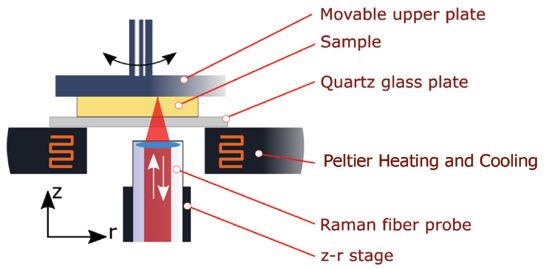
Figure 1: Schematic of the experimental setup.
Sample Preparation
Different types of polyethylene were obtained from Sigma-Aldrich (see Table I), and used without further pretreatment. Before each measurement, the measuring cell was preheated to the set initial temperature. Subsequently, the granulate polymer sample was applied to the heated plate, and the hood was closed. The polymer was fully molten as judged by the normal force, a trimming was conducted, and we waited another 5 min to ensure temperature equilibrium.
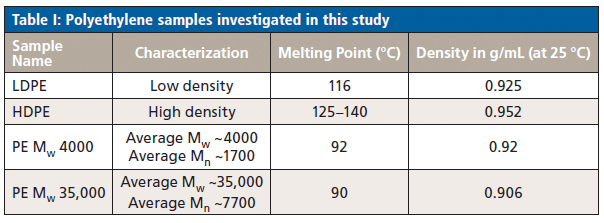
Table II lists the parameters used for the rheological characterization of each polymer. For PE Mw ~4,000, the strain changed from 10% (in the liquid-like phase) to 0.01% in the rubber elastic state. For HDPE, a serrated plate of 15 mm diameter was used to prevent slippage of the sample.

Raman Data Processing
The spectral data of each experiment were pooled into a single data matrix, and processed further in self-written Python scripts. First, Raman spectra were baseline corrected with an iterative Savitzky-Golay filtering algorithm (14) to remove unwanted contributions from fluorescence. Spectral decomposition into two components was performed by using the pyMCR package (15).
Furthermore, only a rough selection of the different component spectra is necessary prior to the analysis. In the case of this study, it was assumed that there are two different phases in the systems studied, a liquid-amorphous and a crystalline phase.
Results and Discussion
Rheological Characterization
Figure 2 shows a comparison of the rheological characterization of all four polymer samples. The samples are partially crystalline polymers, showing a partially homogeneous superstructure where crystalline zones are combined with amorphous regions. An increasing temperature increases the mobility of the macromolecules in the amorphous regions, which leads to a decrease of the storage modulus G', and the loss modulus G". When reaching the melting temperature, the crystalline zones in the polymer start to melt as well. The intersection where G" becomes larger than G' indicates the molten state predominantly showing a viscoelastic behavior.
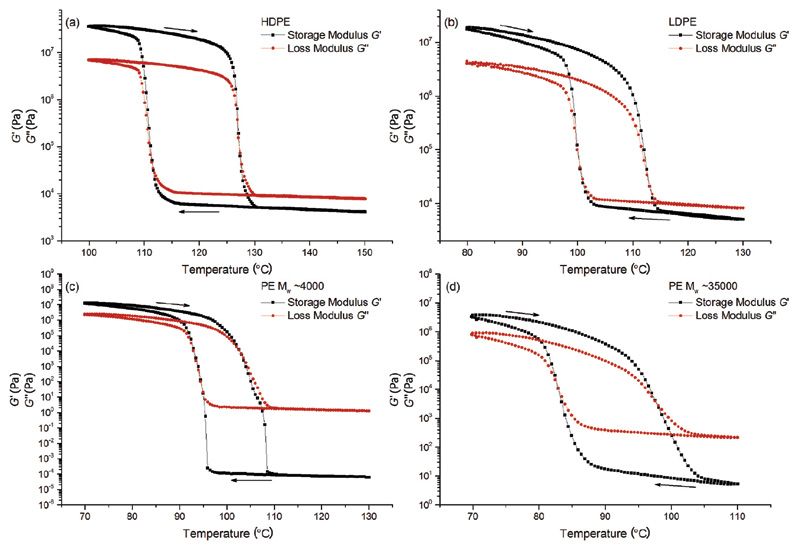
Figure 2: Comparison of the viscoelastic behavior of (a) HDPE, (b) LDPE, (c) PE Mw ~4,000, and (d) PE Mw ~35,000 over the temperature sweep measurement. The lower limit for the measurement of G' and G'' is 10-4 for the rheometer used.
Each type of PE shows an individual trend of G' and G" during cooling and heating (see Figure 2a–d) as they differ greatly in their crystallization properties. Furthermore, crystal structure and the degree of crystallization depend strongly on the heating and cooling rate, and therefore on the thermal history, of the sample. Comparing the viscoelastic properties of LDPE and HDPE (Figures 2a and 2b), it can be seen that HDPE exhibits a higher stiffness than LDPE. This is due to its lower degree of branching, and therefore higher degree of crystallinity. For HDPE, it can be expected that the crystals are also larger and more uniform than those of LDPE. Figure 2c shows the rheological characterization of the PE sample with average molecular weight of 4000. Due to the very short average chain length (average 1700 monomers per polymer), this sample exhibits the lowest viscosity of the tested PEs. The rheological characterization of the sample with average molecular weight of 35,000, and the highest polydispersity is shown in Figure 2d. The shape of the G' and G" curves is very smooth, which confirms its lower crystallinity (1) compared to the other three samples.
Determination of Melting Points from Rheological Measurements
During the oscillatory tests, both the storage modulus G' and the loss modulus G" are recorded. While G' describes the elastic behavior of the material, G", gives information about the viscous contribution of the material's behavior, due to deformation energy which is lost by the relative motion between molecules, structures, and crystals (1).
The solidification temperature, which is the crystallization temperature in case of crystal forming materials such as PE, is determined by cooling a molten sample, and finding the intersection of G'(T) and G"(T). Below the crystallization temperature, the sample is in a rubbery state, G' is larger than G", and the material responds essentially as an elastic solid. When heating the sample, the melting point is determined in a similar way by the point of intersection.

Table III shows the comparison of melting and crystallization points for the tested PE samples. The rheologically determined melting and crystallization points show the same trend as the values stated by the manufacturer. However, the respective values differ substantially, which might be caused by undercooling and overheating of the samples.
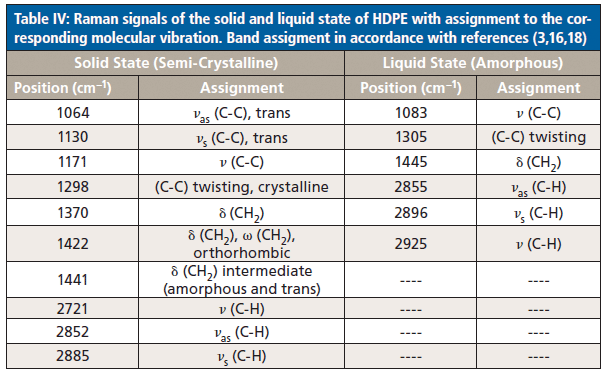
Raman Characterization
Raman spectra differ between solid and liquid HDPE. The phase transition from the solid to the liquid state is reflected by several changes in the Raman spectra, as shown in Figure 3: The band at 1064 cm–1 shifts to higher wavenumber, and gets broader and lower in peak height. The peaks at 1130 cm–1 and 1171 cm–1 vanish completely. Those three bands are associated with the C-C stretching vibrations, the first is the symmetric and the last the asymmetric C-C stretching of the consecutive trans conformations within the polymer chain (3). In the solid state, the trans conformation is preferred, due to the better packing ability, while in the liquid state less ordered structures with many different conformers and a low proportion of consecutive trans conformations are present so that bands associated with trans conformation vanish (16). A similar behavior is found in the region between 1250 cm–1 and 1450 cm–1. Bands associated with the crystalline state vanish (1422 cm–1), or shift to higher wavenumber (1298 cm–1 and 1441 cm–1). A shift to higher wavenumber indicates a stronger intramolecular bond, which may be caused by weaker intermolecular interactions present in the liquid phase compared to the solid phase (17). Table IV lists the peak positions and their corresponding assignment to vibrational bands for the solid and liquid states.
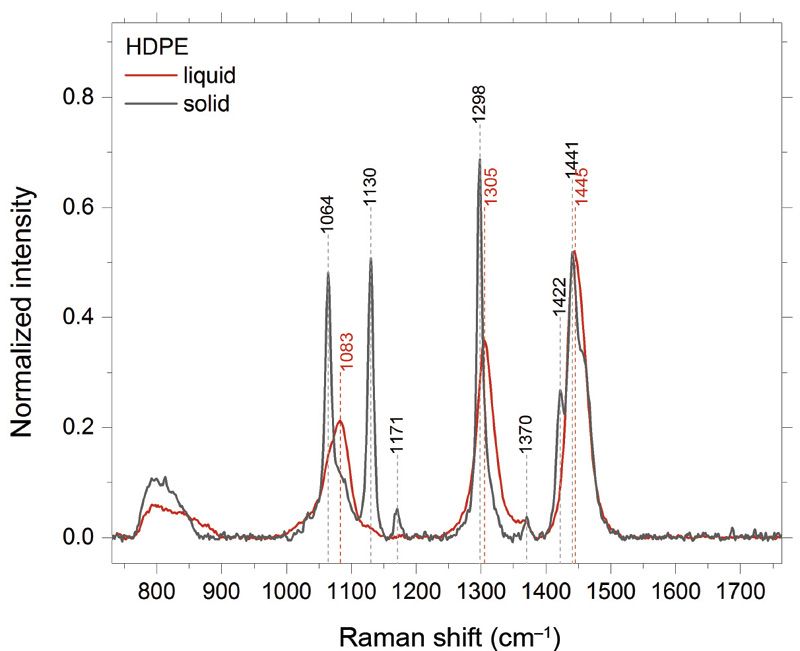
Figure 3: Raman spectra of HDPE in the liquid (red) at 150 °C and solid state (gray) at 100 °C. Both spectra were normalized to the maximum of the CH band between 2800 to 3200 cm-1.
Spectral Comparison of the Four Polyethylenes in the Solid State
The four polyethylene samples provide similar Raman spectra, yet several peaks vary in relative intensity (Figure 4). The polymers with a lower degree of crystallinity result in a spectral signature, which contains contributions of Raman peaks assigned to the crystalline and amorphous state. From their relative intensities, the following qualitative order for the degree of crystallinity may be deduced:
HDPE > LDPE ˜ PE Mw 4000 >PE Mw 35,000
The lower degree of crystallinity of PE Mw 35,000 compared to PE Mw 4000 matches their polydispersity indices. Furthermore, the order of crystallinity deduced from the Raman spectra is in good agreement with the density values given by the manufacturer. Because density and crystallinity are linearly correlated, the Raman spectra can be used to determine the densities of the samples relative to each other.
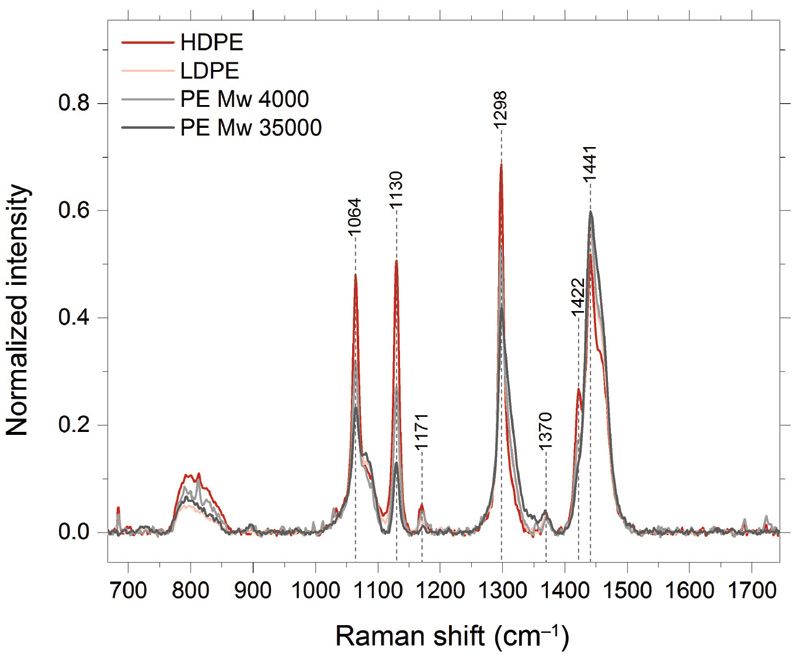
Figure 4: Raman spectra of the four polyethylene samples in the solid state.
MCR-ALS Analysis
MCR-ALS is a popular chemometric algorithm for decomposing spectral data matrices of mixtures into a set of pure components and their respective loadings, as it requires only little prior information about the mixture (12,19). Similar to principal component analysis, MCR finds a maximal explained variance in the spectral data of one experiment, but additionally considers constraints such as non-negativity (11,19). This is advantageous over the manual selection of unique Raman peaks, as the entire spectrum is considered to represent the target component. Furthermore, the influence of random noise is reduced by this technique as any uncorrelated signals will be ignored. For HDPE, the resulting two components representing the crystalline and liquid phases are fully reconstructed by the MCR-ALS algorithm, as shown in Figure 5, in direct comparison with the Raman spectra of the chosen state.

Figure 5: Raman spectra and "pure" component spectra obtained by MCR-ALS for (a)liquid and (b) solid-crystalline HDPE, showing identical spectral features.
From the obtained loadings of both components in each measurement a concentration curve over the temperature was obtained.
Correlation of the Spectral and Rheological Characterization
The component loadings found by MCR-ALS were compared with the simultaneous rheological characterization of each sample. Because the storage modulus G' and component 2 are both associated with the solid state of the polymers, a qualitative analysis of the sample properties is possible. Figure 6 shows the storage modulus G' and the behavior of component c2 over the temperature range. While G' monitors the elastic behavior of the sample, c2 is a measure for the crystalline polymers present in the sample.
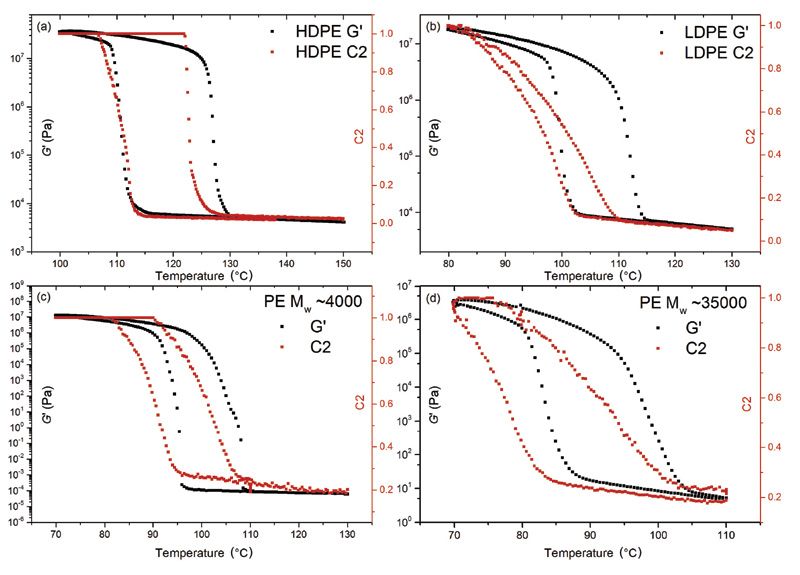
Figure 6: Correlation of the storage modulus G' from the rheological measurement and component c2 from the MCR-ALS analysis of the Raman spectra for the four different polyethylene samples.
For HDPE (Figure 6a), the cooling curves of both parameters show a large increase at approximately 110 °C, which indicates a direct correlation of the crystallization with the storage modulus. For the subsequent heating curve, this correlation is less pronounced. The component c2 already decreases above temperatures of 123 °C, whereas the storage modulus stays high until a temperature of 127 °C.
The Raman data show that HDPE already undergoes a transition from the semicrystalline to the fully amorphous state, while still being a solid material of high storage modulus. Given that the Raman signals of amorphous solid and liquid do not differ substantially, the two states are not distinguished as different components in the MCR-ALS analysis.
For LDPE (Figure 6b), the determined G' and component c2 differ substantially. While the rheological measurement shows a typical hysteresis with a steep transition region, the curve for component c2 shows a very shallow slope. Kempf and colleagues monitored the transition of LDPE via rheo-Raman in 2017. Their approach featured a lower cooling rate near the transition temperature of 0.2 °C/min. They used two distinct bands of the crystalline and amorphous phases for Raman characterization. With this approach, good coincidence between rheological and Raman peak intensity curves was obtained (20). Therefore, we assume that, in the case of this experiment, the measurement parameters were not optimally chosen. The cooling and heating rate was too large for the LDPE sample. The crystallization seems to be kinetically hindered. A further study with a smaller cooling rate might resolve the difference in behavior.
PE with a molecular weight of approximately 4000 (Figure 6c) results in a behavior similar to that shown by HDPE. The Raman curve is shifted to lower temperature for the cooling as well as the heating process. Again, this fact may be correlated to a crystalline amorphous transition.
For the fourth tested sample, PE Mw 35,000 (Figure 6d), which exhibits a large polydispersity, we find that the difference in the start temperatures of the transitions between rheological and Raman curves is even larger than for the sample, PE Mw 4000. Here, the amount of crystalline phase within the fully solidified polymer is the lowest of the four samples studied. Therefore, the crystallization starts at a very late point in the measurement. The rheological curve is very smooth, which indicates that the polymer exhibits a larger number of amorphous regions than the other three samples (1).
The loading of component c2 never reaches zero for sample PE MW 4000 and PE MW 35,000. Because the spectra of the fully solidified samples (defined as component c2 = 1) are a superposition of the crystalline signals with a substantial number of amorphous signals, this is an expected behavior.
Conclusion
A simultaneous rheo-Raman characterization of four different types of polyethylene was conducted by coupling a Raman spectrometer to a rheometer, via an optical fiber probe. Raman spectra of PE in its solid state yielded a trend on the crystallinity, which correlates with the density of the tested samples. By employing a chemometric analysis of the Raman data, additional information on the change of the crystallization state with temperature was obtained. It was shown that the transition to the solid phase, observed from the rheological characterization, starts at higher temperatures than the crystallization indicated by the Raman data. We therefore conclude that PE for the employed parameters first undergoes a transition from the amorphous liquid to an amorphous solid state, and later on starts to crystallize.
Acknowledgements
We are grateful to Alexander Klutz, Thomas Mezger and Roman Führer for helpful and critical discussions.
References
(1) T.G. Mezger, The Rheology Handbook (Vincentz Network GmbH and Co KG, Hannover, Germany, 2nd Ed., 2006).
(2) C.K. Chai, N.M. Dixon, D.L. Gerrard, and W Reed, Polymer 36(3), 661–663 (1995).
(3) T. Kida, Y. Hiejima, and K. Nitta, Int. J. Exp. Spectroscopic. Tech. 1(1), (2016).
(4) T. Kida, Y. Hiejima, and K. Nitta, Polym. Int. 67, 335–1340 (2018).
(5) S. Farquharson, J. Carignan, V. Kitrov, A. Senador, and M. Shaw, Proc. of SPIE, 5272 (2004).
(6) A.P. Kotula, M.W. Meer, F. De Vito, J. Plog, A.R. Hight Walker, and K.B. Migler, Rev. Sci. Instrum. 87, 105105 (2016).
(7) A.P. Kotula and K. B. Migler, J.Rheol. 62(1), 343–356 (2018).
(8) K.S. Whiteley, Ullmann's Encyclopedia of Industrial Chemistry (Wiley-VCH Verlag GmbH, Weinheim, Germany, 2012), pp. 2–37.
(9) C. Vasile and M. Pascu, Practical Guide to Polyethylene (Rapra Technology Press, Srewsbury, United Kingdom, 2005).
(10) M. Nic, J. Jirat, and B. Kosata, The IUPAC Gold Book, online (2017).
(11) R. Tauler, Chemom. Intell. Lab.Syst. 30, 133–146 (1995).
(12) J. Felten, H. Hall, J. Jaumot, R. Tauler, A. de Juan, and A. Gorzsás., Nat. Protoc.10(2), 217 (,2015).
(13) C. Wang, L. Zeng, Z. Li, and D. Li, J. Raman Spectrosc. 48(8), 1040–1055 (2017).
(14) J. Zhao, H. Lui, D.I. McLean, and H. Zeng, Appl. Spectrosc..61(11), 225 (2007).
(15) C.H. Camp, J. Res. Natl. Inst. Stan. 124:124018. https://doi.org/10.6028/jres.124.018 (2019).
(16) Y. Jin, A.P. Kotula, C.R. Snyder, A.R. Hight Walker, K.B. Migler, and Y. Jong Lee, Macromolecules 50, 6174–6183 (2017).
(17) G.A. Voyiatzis and G.N. Papatheodorou, Ber. Bunseng. Phys. Chem.98, 683–689 (1994).
(18) K.B. Migler, A.P. Kotula, and A.R. Hight Walker, Macromolecules, 48, 4555–4561 (2015).
(19) C. Ruckebusch and L. Blanchet, Anal. Chim. Acta 765, 28–36 (2013).
(20) M. Kempf, B. Dippel, and O. Arnolds. Ann. Trans. Nord. Rheol. Soc. 25, 81 (2017).
Frederik Fleissner, Katharina E. Napp, and Boris Wezisla are with Anton Paar OptoTec GmbH, in Seelze-Letter, Germany. Loredana Völker-Pop is with Anton Paar Germany GmbH, in Ostfildern-Scharnhausen Germany. Direct correspondence to frederik.fleissner@anton-paar.com

AI-Powered SERS Spectroscopy Breakthrough Boosts Safety of Medicinal Food Products
April 16th 2025A new deep learning-enhanced spectroscopic platform—SERSome—developed by researchers in China and Finland, identifies medicinal and edible homologs (MEHs) with 98% accuracy. This innovation could revolutionize safety and quality control in the growing MEH market.
New Raman Spectroscopy Method Enhances Real-Time Monitoring Across Fermentation Processes
April 15th 2025Researchers at Delft University of Technology have developed a novel method using single compound spectra to enhance the transferability and accuracy of Raman spectroscopy models for real-time fermentation monitoring.
Nanometer-Scale Studies Using Tip Enhanced Raman Spectroscopy
February 8th 2013Volker Deckert, the winner of the 2013 Charles Mann Award, is advancing the use of tip enhanced Raman spectroscopy (TERS) to push the lateral resolution of vibrational spectroscopy well below the Abbe limit, to achieve single-molecule sensitivity. Because the tip can be moved with sub-nanometer precision, structural information with unmatched spatial resolution can be achieved without the need of specific labels.